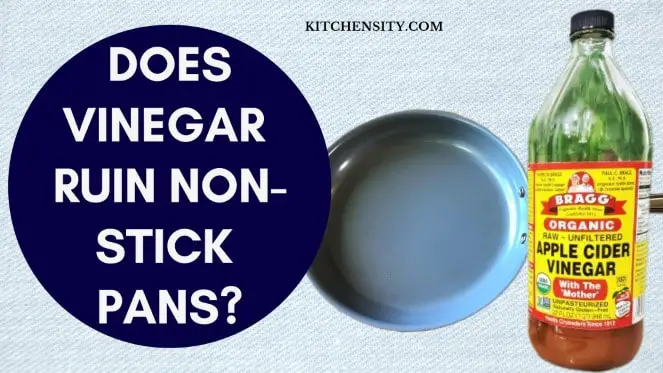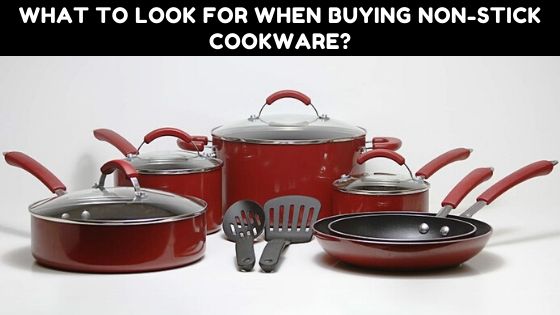When it comes to cleaning kitchenware, the dishwasher is a convenient appliance that can save time and effort.
However, when it comes to non-stick pans, the question arises: can you put them in the dishwasher?
Non-stick pans have become a staple in many kitchens, making cooking and cleaning a breeze. But understanding the proper care and maintenance of these pans is crucial to preserving their quality and longevity.
In this article, we will delve into the topic of whether or not non-stick pans can be safely placed in the dishwasher.
We will explore the advantages, potential risks, and alternative cleaning methods to help you make an informed decision and keep your non-stick pans in optimal condition.
So, let’s find out if your non-stick pans are dishwasher-friendly or if handwashing is the way to go!

Table of Contents
- 1 Can You Put Non-Stick Pans In The Dishwasher?
- 2 Understanding Non-Stick Pans
- 3 Check For Dishwasher-Safe Labels
- 4 Advantages Of Dishwasher-Safe Non-Stick Pans
- 5 Potential Risks Of Dishwashing Non-Stick Pans
- 6 Best Way To Clean Non-Stick Pans (By Hand)
- 7 Proper Maintenance For Longevity
- 8 Final Verdict
- 9 You May Also Like
- 10 Frequently Asked Questions (FAQs)
- 10.1 What Happens If You Put A Nonstick Pan In The Dishwasher?
- 10.2 Why Can’t Pots And Pans Go In The Dishwasher?
- 10.3 What Are The Best Nonstick Pans That Can Go In The Dishwasher?
- 10.4 Can I Put A Non-Stick Pan With A Wooden Handle In The Dishwasher?
- 10.5 Can I Use Metal Utensils On Non-Stick Pans?
- 10.6 Are Ceramic-Coated Non-Stick Pans Dishwasher-Safe?
- 10.7 Can I Use Bleach To Clean Non-Stick Pans?
- 10.8 How Often Should I Replace My Non-Stick Pans?
Can You Put Non-Stick Pans In The Dishwasher?
Yes, many non-stick pans are dishwasher-safe, but it is important to check the manufacturer’s instructions or product packaging to confirm if your specific pan can be safely cleaned in the dishwasher. Handwashing is generally recommended to maintain the non-stick coating’s integrity and prolong the pan’s lifespan.
Also Read – How To Tell If A Pan Is Non-Stick?
Understanding Non-Stick Pans
- Coating Types:
- Polytetrafluoroethylene (PTFE) Coating: Most non-stick pans feature a PTFE coating, commonly known as Teflon. This coating provides a smooth surface that prevents food from sticking.
- Ceramic-based Coating: Some non-stick pans utilize ceramic-based coatings as an alternative to PTFE. These coatings are typically made from natural materials and offer similar non-stick properties.
- Benefits Of Non-Stick Pans:
- Easy Food Release: The non-stick coating allows food to slide off the pan effortlessly, reducing the need for excessive oil or butter and making cooking and flipping food more convenient.
- Simple Cleanup: Non-stick pans are easy to clean due to their non-stick surface. Food residue is less likely to stick, requiring minimal scrubbing and soaking.
- Healthier Cooking: With a non-stick pan, you can reduce the amount of oil or fat used in cooking, promoting healthier meal preparation.
- Versatility: Non-stick pans are suitable for a wide range of cooking techniques, including frying, sautéing, and making delicate dishes such as omelets and pancakes.
- Proper Care For Non-Stick Pans:
- Use Gentle Utensils: Avoid using metal utensils that can scratch or damage the non-stick coating. Opt for silicone, wood, or nylon utensils instead.
- Moderate Heat: Excessive heat can damage the non-stick coating. Follow the manufacturer’s guidelines regarding recommended temperature limits.
- Handwashing: While some non-stick pans are labeled as dishwasher-safe, handwashing is generally recommended to preserve the integrity of the coating and extend the pan’s lifespan.
- Avoid Abrasive Cleaners: Harsh abrasives, scouring pads, or steel wool should be avoided as they can scratch or wear down the non-stick coating.
- Proper Storage: To prevent scratching or damaging the non-stick surface, stack non-stick pans with care, using protective layers or pan protectors.
Also Read – How To Get Sticky Residue Off Non-Stick Pans?
Check For Dishwasher-Safe Labels
Dishwasher-safe labels on non-stick pans play a crucial role in providing clear guidance to consumers regarding the appropriate cleaning method. These labels are typically placed on the packaging or directly on the pan itself, indicating that the product has undergone testing to withstand the dishwasher’s conditions.
- When non-stick pans are labeled as dishwasher-safe, it means that the manufacturer has conducted rigorous tests to ensure that the pan can endure the heat and detergents used in dishwashers without sustaining damage.
- This testing process is vital to guarantee the pan’s quality and performance, as well as to maintain the integrity of the non-stick coating.
- The specific tests performed may vary among manufacturers, but they typically involve subjecting the pans to simulated dishwasher cycles. This entails exposing the pans to high temperatures and powerful detergents to evaluate their durability.
- The goal is to ensure that the non-stick coating remains intact and the pan maintains its functionality even after repeated dishwasher use.
To determine if your non-stick pan is dishwasher-safe, it’s important to carefully read the product packaging or consult the manufacturer’s instructions.
- Look for explicit indications or symbols that specify the dishwasher-safe status. These labels ensure that the pan has undergone the necessary testing and can be safely cleaned using this method.
- While dishwasher-safe labels are a reliable indicator, it’s essential to note that not all non-stick pans possess this designation.
- Some pans may require handwashing to preserve their quality and extend their lifespan.
- Therefore, it’s crucial to follow the manufacturer’s instructions to ensure the proper care and maintenance of your non-stick pan.
By adhering to the recommended cleaning methods, whether it’s dishwasher-safe or handwashing, you can effectively maintain the performance and longevity of your non-stick pans.
Proper care and attention will allow you to enjoy the benefits of non-stick cooking while ensuring that your pans remain in excellent condition for years to come.
Also Read – Does Vinegar Ruin Non-Stick Pans?
Advantages Of Dishwasher-Safe Non-Stick Pans
Dishwasher-safe non-stick pans offer several advantages when it comes to cleaning and maintenance. Let’s delve into these benefits:
- Time And Effort Saving:
- Using the dishwasher to clean your non-stick pans saves you valuable time and effort.
- Instead of manually scrubbing and washing the pan by hand, you can simply load it into the dishwasher and let the machine take care of the cleaning process.
- This convenience is especially beneficial when you have a busy schedule or after preparing a meal that leaves you with multiple dishes to clean.
- Thorough Cleaning:
- Dishwashers utilize hot water and powerful detergents to provide a thorough cleaning experience for your non-stick pans.
- The combination of heat and detergents helps to remove stubborn grease, oils, and food particles that may have adhered to the surface of the pan during cooking.
- The vigorous cleaning action of the dishwasher ensures that your pans are left sparkling clean and ready for their next use.
- Effective Grease And Food Particle Removal:
- Non-stick pans, despite their excellent non-stick properties, can still accumulate residual grease and food particles over time.
- Dishwashers are designed to tackle these issues effectively.
- The hot water and strong detergents used in dishwashers help to break down and remove grease and food residues, leaving your non-stick pans thoroughly clean and free from any lingering odors.
- Preserves Pristine Condition:
- When you place your dishwasher-safe non-stick pans in the dishwasher, you can have confidence that they will be cleaned without compromising their condition.
- These pans are specifically engineered and tested to withstand the dishwasher’s heat and detergents without sustaining damage.
- By using the dishwasher, you can maintain the pristine condition of your non-stick pans, ensuring they remain in excellent shape for long-term use.
- Convenient And Versatile:
- Dishwasher-safe non-stick pans offer convenience and versatility in your kitchen routine.
- You can effortlessly incorporate them into your dishwasher load, alongside other dishes and utensils, without the need for separate handwashing.
- This flexibility allows you to efficiently clean multiple items at once, saving you time and effort in the kitchen cleanup process.
It’s important to note that while dishwasher-safe non-stick pans offer these advantages, it’s still crucial to follow the manufacturer’s instructions and exercise proper care to maximize the lifespan of your pans.
Additionally, it’s recommended to regularly inspect the condition of the non-stick coating to ensure it remains intact and functional over time.
Also Read – How To Fix Scratched Non-Stick Pans?
Potential Risks Of Dishwashing Non-Stick Pans
Although non-stick pans labeled as dishwasher-safe are designed to withstand the dishwasher’s conditions, there are still potential risks associated with dishwashing them.
It’s important to be aware of these risks to ensure the longevity and performance of your non-stick pans. Here are some potential risks to consider:
- Degradation Of Non-Stick Coating:
- The high heat and harsh detergents used in dishwashers can gradually degrade the non-stick coating of the pans over time.
- Repeated exposure to these elements may cause the coating to chip, peel, or wear off, compromising its non-stick properties.
- This can result in food sticking to the surface and a diminished cooking experience.
- Reduction In Effectiveness:
- When the non-stick coating of a pan degrades, its effectiveness in preventing food from sticking is significantly reduced.
- As a result, you may need to use more oil or butter to prevent sticking, defeating the purpose of using a non-stick pan.
- The pan may also become more challenging to clean as food residues adhere to the damaged coating.
- Scratches And Dents:
- If the non-stick pan is not properly secured or positioned in the dishwasher, it may move around during the dishwasher’s cycle.
- This movement can cause the pan to collide with other dishes or the dishwasher’s interior, resulting in scratches or dents on the pan’s surface.
- These physical damages can further compromise the non-stick coating and lead to uneven cooking or food sticking in specific areas.
- Impact On Longevity:
- The degradation of the non-stick coating due to dishwashing can significantly impact the lifespan of the pan.
- With each dishwasher cycle, the coating may become more susceptible to damage, reducing the overall durability of the pan.
- This can lead to the need for more frequent replacement, adding to the cost and inconvenience.
To mitigate these risks, it’s important to follow the manufacturer’s instructions regarding dishwasher use for your non-stick pans.
If the manufacturer recommends handwashing, it’s best to opt for this method to preserve the integrity of the non-stick coating.
When placing non-stick pans in the dishwasher, ensure they are securely positioned and not in direct contact with other dishes or the dishwasher’s components.
Regularly inspect the condition of the non-stick coating, looking for signs of chipping, peeling, or wear. If you notice any damage, it’s advisable to discontinue using the pan in the dishwasher and switch to handwashing instead.
By properly caring for your non-stick pans, you can prolong their lifespan and maintain their optimal performance.
Also Read – How To Remove The Non-Stick Coating From Cookware?
Best Way To Clean Non-Stick Pans (By Hand)
Handwashing non-stick pans is a preferred cleaning method, as it allows for a more gentle approach that minimizes the risk of damaging the non-stick coating.
To properly clean your non-stick pans by hand, follow these steps:
- Gather The Necessary Materials: Prepare warm water, mild dish soap, a soft sponge or cloth, and a non-abrasive brush or nylon scrubber.
- Let The Pan Cool Down: After use, allow the non-stick pan to cool down before washing. Placing a hot pan directly into water or using cold water can cause thermal shock and potentially damage the pan.
- Remove Excess Residue: Using a paper towel or soft cloth, gently wipe away any excess food or grease from the pan’s surface. Be careful not to apply too much pressure or scrub vigorously, as this can scratch the non-stick coating.
- Fill The Sink With Warm, Soapy Water: Fill your sink or a basin with warm water and add a small amount of mild dish soap. Swirl the water to create a soapy solution.
- Submerge The Pan: Place the non-stick pan into the soapy water, ensuring that the water covers the cooking surface. Let it soak for a few minutes to loosen any remaining food particles.
- Clean The Pan’s Surface: Using a soft sponge or cloth, gently scrub the pan’s surface in circular motions. Focus on areas with stubborn residue, but avoid using abrasive materials or harsh cleaners that can scratch or wear down the non-stick coating. For difficult-to-remove residue, you can use a non-abrasive brush or nylon scrubber.
- Rinse Thoroughly: Once you’ve cleaned the pan, rinse it thoroughly under warm running water. Ensure that all soap residue is removed from both the inside and outside of the pan.
- Dry Completely: After rinsing, use a soft towel or dishcloth to dry the non-stick pan thoroughly. It’s important to eliminate any moisture to prevent water spots, potential rust formation, or damage to the pan’s surface.
- Store Properly: Before storing the pan, ensure it is completely dry. Store non-stick pans in a cool, dry place, preferably with a protective layer between them to prevent scratches or dents.
By handwashing your non-stick pans using these gentle cleaning methods, you can maintain their performance and extend their lifespan.
Remember to always refer to the manufacturer’s instructions for specific care recommendations to ensure the best care for your particular non-stick pan.
Also Read – Why Do Metal Handles Of Pans Get Hot?
Proper Maintenance For Longevity
To keep your non-stick pans in optimal condition, here are a few maintenance tips to follow:
- Use Non-Metal Utensils: When cooking with non-stick pans, opt for non-metal utensils, such as silicone or wooden spatulas. Metal utensils can scratch the non-stick coating, reducing its effectiveness.
- Avoid High Heat: Excessive heat can damage the non-stick coating. Stick to medium or low heat settings when using non-stick pans to prevent the coating from deteriorating.
- Hand Dry After Washing: After cleaning your non-stick pans, make sure to thoroughly dry them to prevent water spots and potential rust formation.
- Store Properly: To avoid scratches and dents, store your non-stick pans carefully. Consider using pan protectors or stacking them with a soft cloth or paper towels in between.
Also Read – What To Look For When Buying Non-Stick Cookware?
Final Verdict
So, the question of whether non-stick pans can be safely placed in the dishwasher depends on various factors.
While some non-stick pans are labeled as dishwasher-safe, it is important to consider the manufacturer’s instructions and recommendations specific to your pan.
The dishwasher’s high heat, strong detergents, and agitation can potentially damage the non-stick coating over time. To ensure the longevity and effectiveness of your non-stick pans, handwashing is generally the preferred method.
By following proper care guidelines, using gentle utensils, and avoiding abrasive cleaners, you can maintain the quality of your non-stick pans and enjoy their benefits for many delicious meals to come.
Remember to always refer to the manufacturer’s instructions for the best care practices.
You May Also Like
- Best Non-Stick Cookware Brands
- Best Nonstick Pans for Gas Stoves
- All-Clad 4110 NS R2 Non-Stick Fry Pan Review
- How to Season a Nonstick Pan for First Time?
- How To Get Burnt Sugar Off A Pan?
- Tart Pan Substitutes
- How Many Mini Loaf Pans Equal A Regular Loaf Pan?
- Can You Bake A Cake In A Springform Pan?
Frequently Asked Questions (FAQs)
-
What Happens If You Put A Nonstick Pan In The Dishwasher?
Putting a non-stick pan in the dishwasher, especially if it is not labeled as dishwasher-safe, can potentially damage the pan. The dishwasher’s high heat and harsh detergents can degrade the non-stick coating over time, causing it to chip, peel, or become less effective. It is advisable to follow the manufacturer’s instructions and handwash non-stick pans to maintain their quality and longevity.
-
Why Can’t Pots And Pans Go In The Dishwasher?
Pots and pans, particularly those with non-stick coatings, are not recommended for dishwasher use due to the potential damage caused by high heat, detergents, and agitation during the dishwasher cycle. It’s best to handwash them to maintain their quality.
-
What Are The Best Nonstick Pans That Can Go In The Dishwasher?
When it comes to non-stick pans that can go in the dishwasher, it’s important to check the manufacturer’s instructions or product labeling. Some non-stick pans are specifically designed and labeled as dishwasher-safe, indicating that they have undergone testing to withstand the dishwasher’s conditions without damage.
-
Can I Put A Non-Stick Pan With A Wooden Handle In The Dishwasher?
Yes, as long as the pan itself is dishwasher-safe, the wooden handle should be fine. However, it’s always best to refer to the manufacturer’s instructions to ensure proper care.
-
Can I Use Metal Utensils On Non-Stick Pans?
Using metal utensils can scratch the non-stick coating and reduce its effectiveness. It’s recommended to use non-metal utensils, such as silicone or wooden spatulas.
-
Are Ceramic-Coated Non-Stick Pans Dishwasher-Safe?
Most ceramic-coated non-stick pans are dishwasher-safe. However, it’s important to check the manufacturer’s instructions to confirm their dishwasher compatibility.
-
Can I Use Bleach To Clean Non-Stick Pans?
Bleach is not recommended for cleaning non-stick pans, as it can damage the coating. Stick to mild dish soap and warm water for regular cleaning.
-
How Often Should I Replace My Non-Stick Pans?
The lifespan of non-stick pans can vary depending on usage and care. It’s recommended to replace them when the non-stick coating starts to chip, peel, or lose its effectiveness.
Katrina Smith is a seasoned expert with over 25 years of experience in all things related to cooking and the kitchen. As an avid cook and kitchen enthusiast, she is passionate about sharing her knowledge and expertise on cookware, kitchen appliances, kitchen tips, and kitchen staples.
Through her articles and reviews, Katrina aims to inspire and help others improve their cooking skills, experiment with different ingredients, and invest in quality cookware and appliances.






